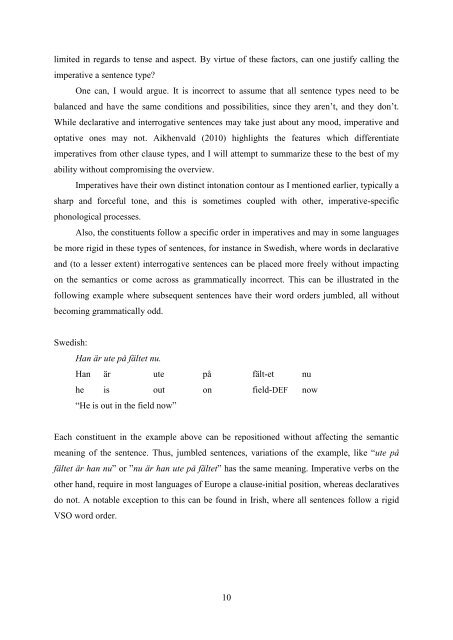The function of non-canonical imperatives in the languages of Europe
The function of non-canonical imperatives in the languages of Europe
The function of non-canonical imperatives in the languages of Europe
You also want an ePaper? Increase the reach of your titles
YUMPU automatically turns print PDFs into web optimized ePapers that Google loves.
limited <strong>in</strong> regards to tense and aspect. By virtue <strong>of</strong> <strong>the</strong>se factors, can one justify call<strong>in</strong>g <strong>the</strong><br />
imperative a sentence type<br />
One can, I would argue. It is <strong>in</strong>correct to assume that all sentence types need to be<br />
balanced and have <strong>the</strong> same conditions and possibilities, s<strong>in</strong>ce <strong>the</strong>y aren’t, and <strong>the</strong>y don’t.<br />
While declarative and <strong>in</strong>terrogative sentences may take just about any mood, imperative and<br />
optative ones may not. Aikhenvald (2010) highlights <strong>the</strong> features which differentiate<br />
<strong>imperatives</strong> from o<strong>the</strong>r clause types, and I will attempt to summarize <strong>the</strong>se to <strong>the</strong> best <strong>of</strong> my<br />
ability without compromis<strong>in</strong>g <strong>the</strong> overview.<br />
Imperatives have <strong>the</strong>ir own dist<strong>in</strong>ct <strong>in</strong>tonation contour as I mentioned earlier, typically a<br />
sharp and forceful tone, and this is sometimes coupled with o<strong>the</strong>r, imperative-specific<br />
phonological processes.<br />
Also, <strong>the</strong> constituents follow a specific order <strong>in</strong> <strong>imperatives</strong> and may <strong>in</strong> some <strong>languages</strong><br />
be more rigid <strong>in</strong> <strong>the</strong>se types <strong>of</strong> sentences, for <strong>in</strong>stance <strong>in</strong> Swedish, where words <strong>in</strong> declarative<br />
and (to a lesser extent) <strong>in</strong>terrogative sentences can be placed more freely without impact<strong>in</strong>g<br />
on <strong>the</strong> semantics or come across as grammatically <strong>in</strong>correct. This can be illustrated <strong>in</strong> <strong>the</strong><br />
follow<strong>in</strong>g example where subsequent sentences have <strong>the</strong>ir word orders jumbled, all without<br />
becom<strong>in</strong>g grammatically odd.<br />
Swedish:<br />
Han är ute på fältet nu.<br />
Han är ute på fält-et nu<br />
he is out on field-DEF now<br />
“He is out <strong>in</strong> <strong>the</strong> field now”<br />
Each constituent <strong>in</strong> <strong>the</strong> example above can be repositioned without affect<strong>in</strong>g <strong>the</strong> semantic<br />
mean<strong>in</strong>g <strong>of</strong> <strong>the</strong> sentence. Thus, jumbled sentences, variations <strong>of</strong> <strong>the</strong> example, like “ute på<br />
fältet är han nu” or ”nu är han ute på fältet” has <strong>the</strong> same mean<strong>in</strong>g. Imperative verbs on <strong>the</strong><br />
o<strong>the</strong>r hand, require <strong>in</strong> most <strong>languages</strong> <strong>of</strong> <strong>Europe</strong> a clause-<strong>in</strong>itial position, whereas declaratives<br />
do not. A notable exception to this can be found <strong>in</strong> Irish, where all sentences follow a rigid<br />
VSO word order.<br />
10
















